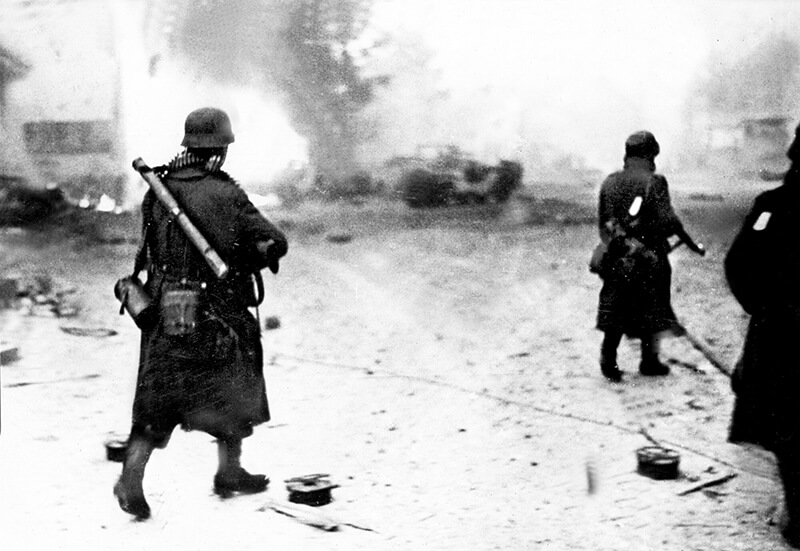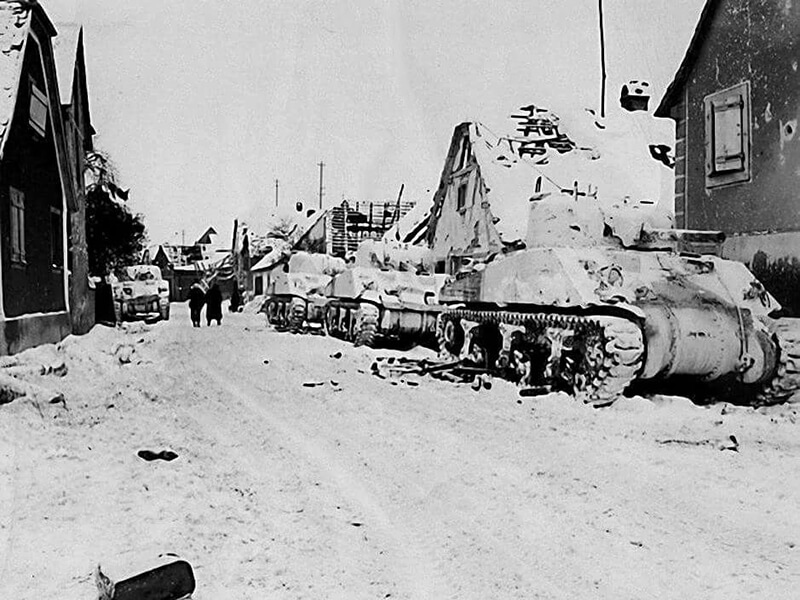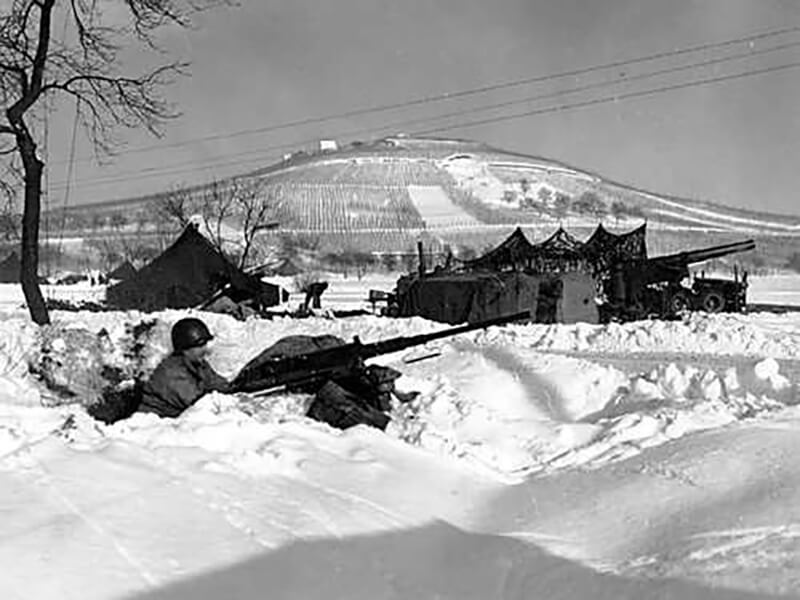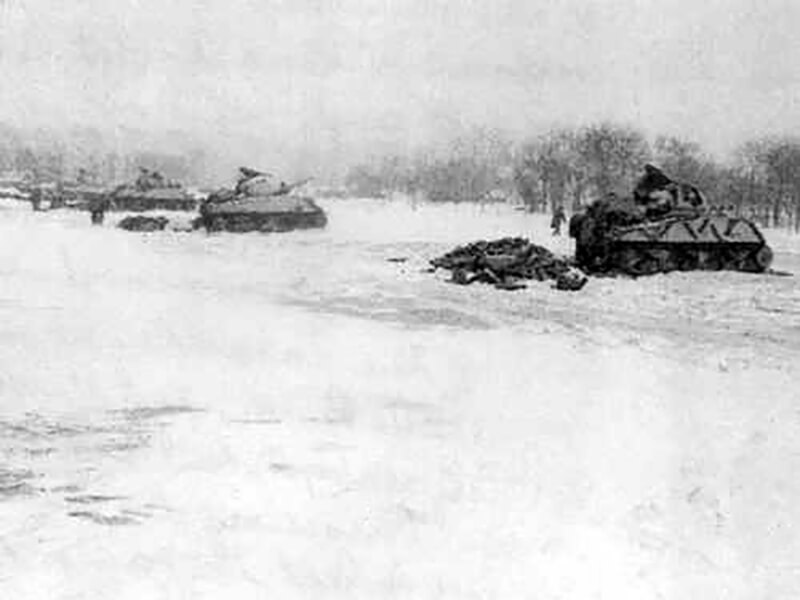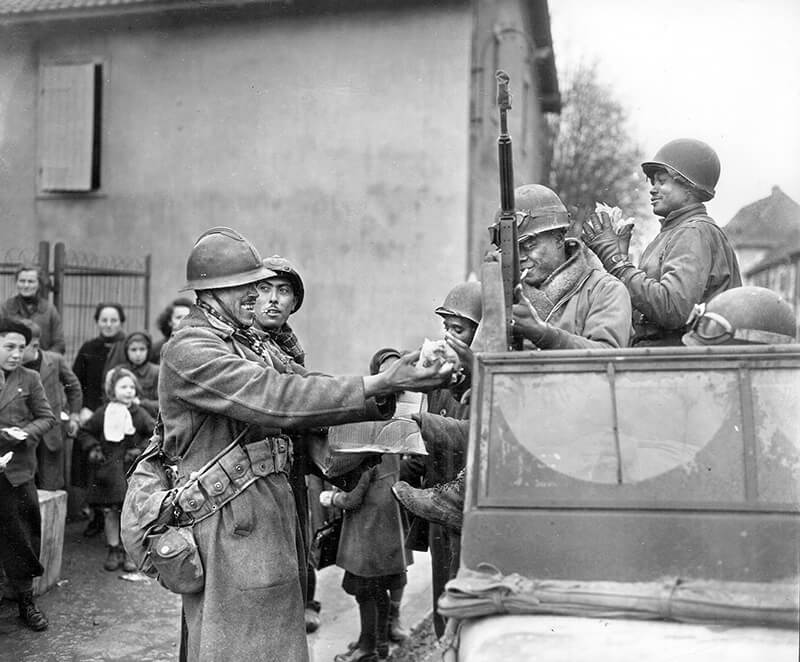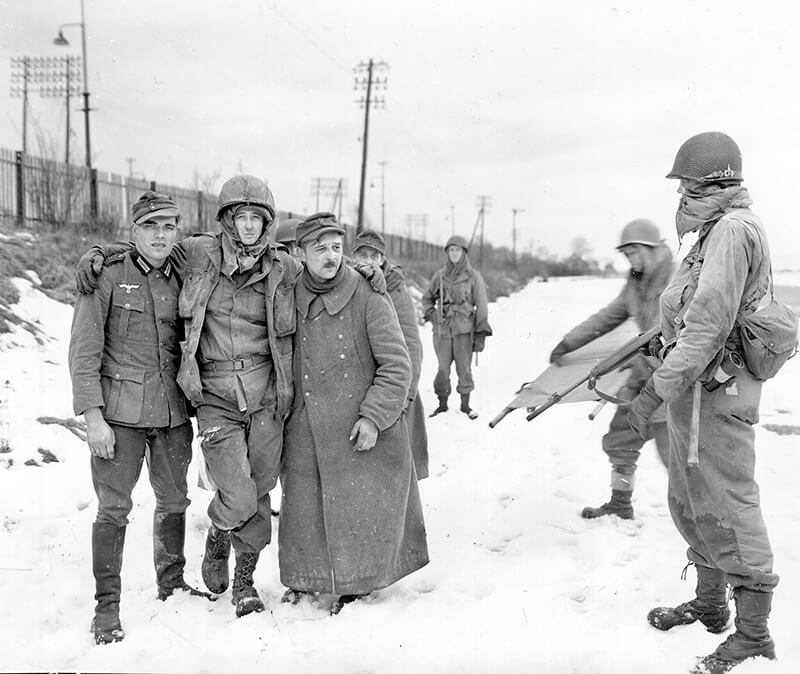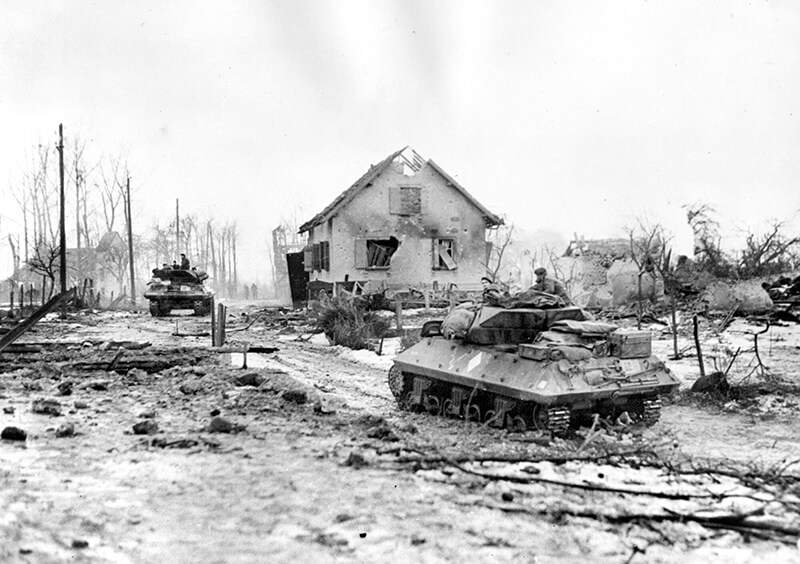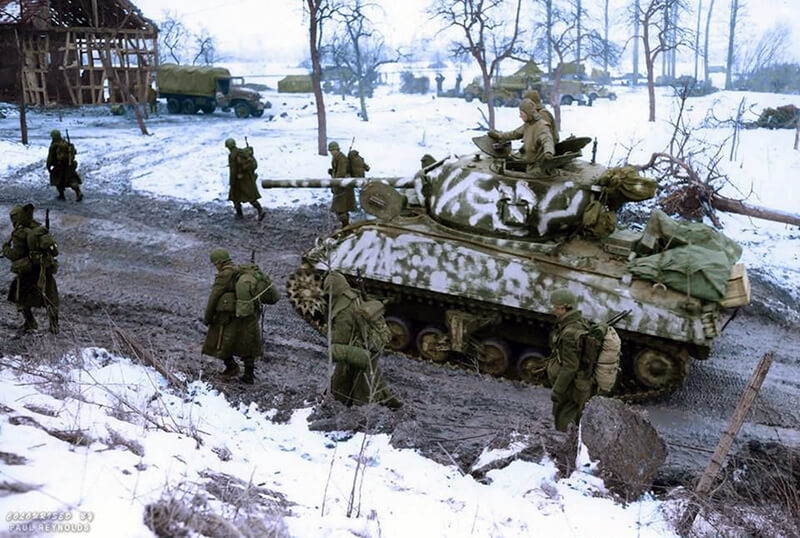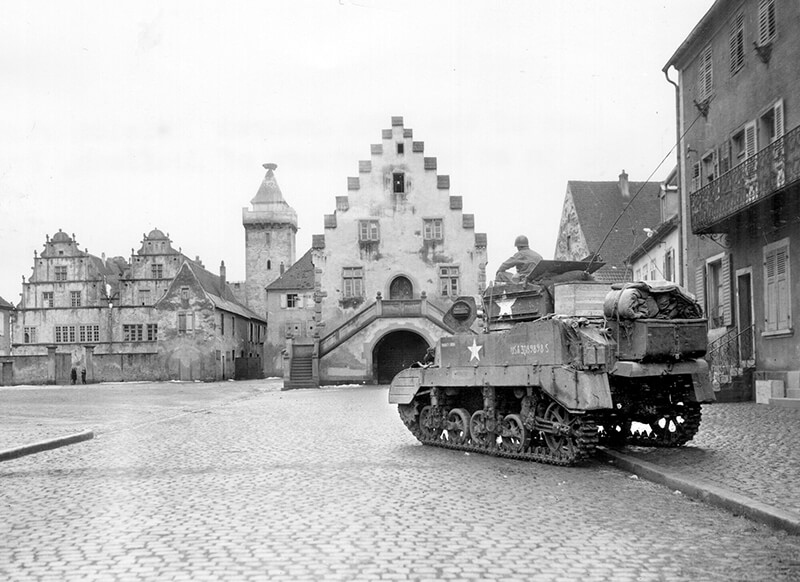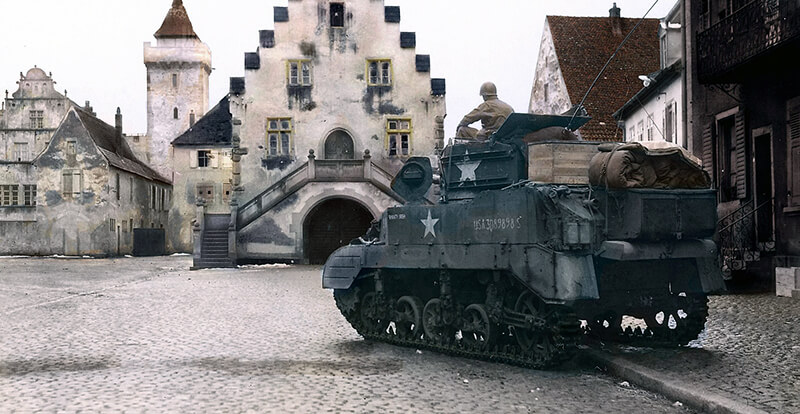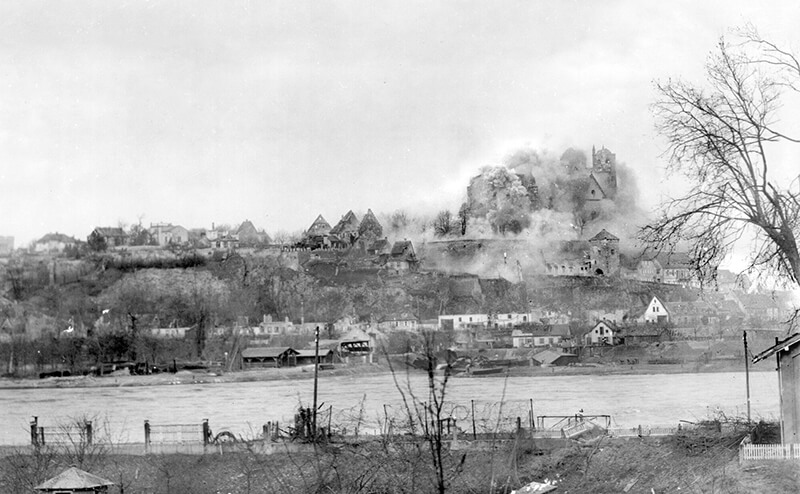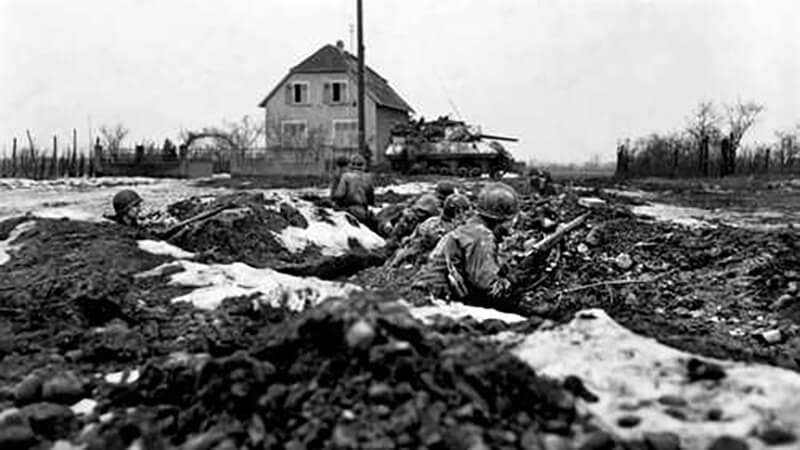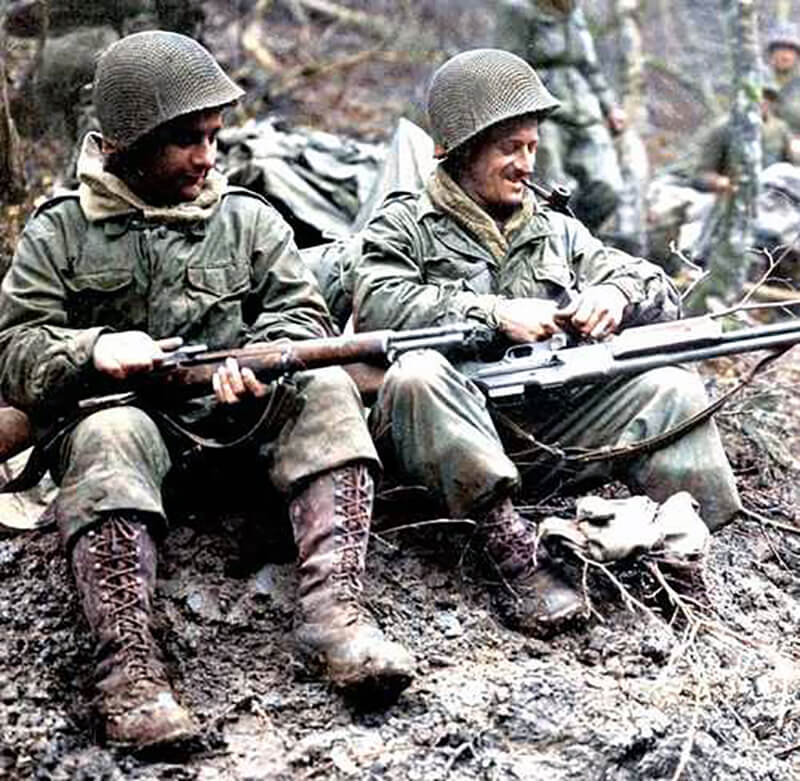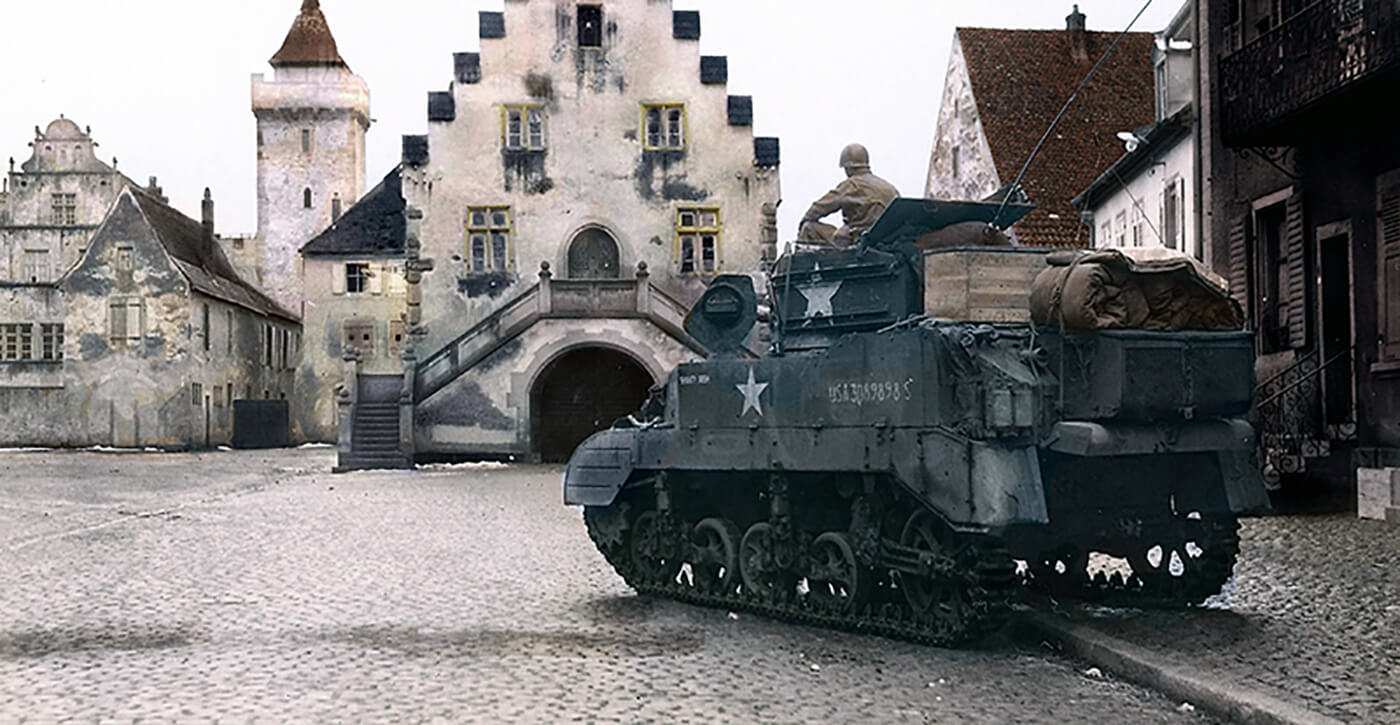| Page Created |
| February 27th, 2024 |
| Last Updated |
| March 1st, 2024 |
| France |
  |
| Special Forces |
| Commandos de Choc 1er Régiment de Chasseurs Parachutistes |
| January 20th, 1945 – February 9th, 1945 |
| The Battle of the Colmar Pocket |
| Objectives |
- Liberate the last part of France occupied by the Germans.
| Operational Area |
Colmar Region, France.
| Unit Force |
- 1er Armée
- 10e Division d’Infanterie
- 1er Corps d’Armée
- 2e Division d’Infanterie Marocaine
- 4e Division Marocaine de Montagne
- 9e Division d’Infanterie Coloniale
- 1re Division Blindée
- 1re Groupement de Commandos de Choc
- 2e Groupement de Commandos de Choc
- 2e Corps d’Armée
- 1re Division Française Libre
- 3e Division d’Infanterie Algérienne
- 2e Division Blindée
- 5e Division Blindée
- 1er Régiment de Chasseurs Parachutistes
- 3rd U.S. Infantry Division
- 254th Infantry Regiment
- 28th U.S. Infantry Division
- 44th U.S. Infantry Division, Company E, 1st Battalion
- U.S. XXI Corps
| Opposing Forces |
- 19. Armee
- Panzer-Abteilung Feldherrnhalle
- 2. Gebirgs Division
- 106. Panzer Brigade
- LXIV Armeekorps
- 198. Infantrie Division
- 189. Infantrie Division
- 708. Volksgrenadier Division
- 16. Volksgrenadier Division
- LXIII Armeekorps
- 338. Infantrie Division
- 159. Infantrie Division
- 716. Infantrie Division
| Operation |
In November 1944, a German bridgehead on the west bank of the Rhine, stretching sixty-five kilometres long and fifty kilometres deep, becomes isolated when the German defenses in the Vosges Mountains crumbles under the pressure of an offensive by the U.S. 6th Army Group. General Jean de Lattre de Tassigny’s French 1er Armée breaks through the Belfort Gap and decisively defeats the German IV Luftwaffe Field Corps near Burnhaupt in the southern Vosges Mountains. Subsequently, French forces advance to the Rhine in the area north of the Swiss border, between Mulhouse and Basel. Simultaneously, in the northern Vosges Mountains, the French 2e Division Blindée leads a successful advance alongside the U.S. Seventh Army, breaches the Saverne Gap, and reaches the Rhine, liberating Strasbourg on November 23rd, 1944. These combined offensives effectively eliminate the German presence in southern Alsace west of the Rhine, forming a semi-circular bridgehead centered on the town of Colmar, which became known as the Colmar Pocket.
The robust German defences in Alsace and Lorraine stemmed from the belief that these regions are integral parts of Germany and deserved to be defended with the same intensity as any other German territory. This perception guides Hitler’s decisions on November 24th, 1944, and November 27th, 1944, when he orders General Siegfried Rasp’s 19. Armee to undertake a determined defence of the Colmar region. On November 26th, 1944, the Germans establish Army Group Oberrhein under the leadership of Heinrich Himmler, tasking it with defending the front stretching from the Bienwald to the Swiss border. Crucial to the German defence in the Colmar area are the bridges over the Rhine at Breisach and Chalampé, as these bridges serve as vital supply routes.
In the second half of January, temperatures plummet dramatically, accompanied by heavy snowfall. “Surely you’re not attacking in this weather,” exclaims Churchill, visiting the French 1er Armée. “Of course not,” responds, General de Lattre de Tassigny, the commander of the army, intent on keeping the attack plans secret, even from a British Prime Minister.
Nevertheless, the commander of the French 1° Armée is keen on launching his offensive to liberate the last piece of French territory still occupied by the German Army. With it the Battle of Colmar is underway. The 1er Corps d’Armée advances from the south, while the 2e Corps d’Armée moves from the northwest to accomplish its mission.
| January 20th, 1945 |
General Émile Béthouart’s French 1er Corps d’Armée launches its attack. The 2e Division d’Infanterie Marocaine and 4e Division Marocaine de Montagne are tasked with capturing Ensisheim as their primary objective. Meanwhile, the 9e Division d’Infanterie Coloniale carries out secondary attacks on the right flank of the Corps, north of Mulhouse. Providing support are tanks from the French 1re Division Blindée.
With the start of the attack the weather is dreadful. Reports describe swirling snow blankets, reducing visibility to zero and creating snowdrifts as high as one meter. Despite these challenging conditions, the French 1er Corps d’Armée manages to catch its opponent, General Erich Abraham’s LXIII. Armeekorps, off guard, achieving tactical surprise.
Especially, the 9e Division d’Infanterie Coloniale (9e DIC) achieves commendable success. By afternoon, despite heavy German resistance, Pfastatt, Lutterbach, Illzach, and Kingershein are under French control.
| January 21th, 1945 |
The harsh conditions continue to bother the advancing French, with freezing temperatures and snowstorms, the French face relentless counterattacks, leaving the men fatigued. General Béthouart swiftly deploys the 1er Groupement de Commandos de Choc, led by Lieutenant Colonel Gambiez and the 2e Groupement de Commandos de Choc, under Commander Quinche to reinforce the 9e Division d’Infanterie Coloniale.
| January 22nd, 1945 |
General Joseph de Goislard de Monsabert’s 2e Corps d’Armée initiates its offensive. The spearheading units include the U.S. 3rd Infantry Division and the French 1re Division Française Libre. Guarding the southern flank of the 3e Division d’Infanterie Algérienne is the U.S. 28th Infantry Division, responsible for defending its sector of the front. Meanwhile, the French 2e Division Blindée remains in reserve, ready to provide support as needed.
General John W. O’Daniel’s 3rd U.S. Infantry Division launches an attack to the southeast. Their objective is to cross the Ill River, bypassing the city of Colmar to the north, and creating a path for the tanks of the French 5e Division Blindée to advance towards the railway bridge supplying the Germans in the Colmar Pocket at Neuf-Brisach.
The 7th Infantry Regiment of the division advances southward, clearing the region between the Fecht and Ill Rivers. Simultaneously, the 30th Infantry Regiment moves southeast and crosses the Ill River north of the timber bridge at the Maison Rouge farm.
| January 23rd, 1945 |
General Garbay’s French 1re Division Française Libre launches an attack to the east, aiming to reach the Rhine River. Their advance faces stout resistance from four battalions of the 708. Volksgrenadier Division, bolstered by heavy tank destroyers and artillery support. Similar to the challenges encountered by the U.S. forces to the south, the French 1re Division Française Libre’s, 1re Brigade fights under tough conditions.
The German defense strategy involves establishing a defence in depth, utilising positions in villages and forests to control the open terrain and strategically deploying land mines to impede the French advance. Despite facing a fierce counterattack by two battalions of the 708. Volksgrenadier Division, the French successfully repel the assault.
To circumvent entrenched German forces in the Elsenheim Woods, General Garbay directed the 1re Brigade to concentrate their advance along the road from Illhaeusern to Elsenheim.
The 9e Division d’Infanterie Coloniale and the four Battalions of the two Groupements de Commandos de Choc encounter fierce German opposition at the cities of Anna and Kuhlman. They manage to occupy only the Meyershof farm and the city of Richwiller that day.
The 4e Compagnie of the 2e Bataillon de Choc reaches Richwiller around 13:00, near the church, with the mission of supporting the battalion’s advance towards the town. Accordingly, the 1st section (Le Coniac) advances on the road from Richwiller to Wittelsheim, while the 2nd and 3rd sections (Gérard and Tassin) position themselves to the right and left of the road. The 4th section (Le Guyader) supports the 1st section. The movement proceeds as planned, with the attacking company making progress without requiring intervention from the support company. As night falls around 17:00, accompanied by snowfall, the initial phase of the attack proves successful, resulting in the capture of Richwiller and occupation of the surrounding woods.
The 30th Infantry Regiment of the 3rd U.S. Infantry Division proceeds to capture the Maison Rouge bridge and then advances southward into the Riedwihr Woods, towards the towns of Riedwihr and Holtzwihr.
However, the bridge at Maison Rouge proves incapable of supporting U.S. tanks, leading to its collapse under the weight of a tank. As a result, the 30th Infantry Regiment has limited anti-tank capabilities, relying mainly on bazookas and three 57 mm anti-tank guns. Later in the afternoon, they face a counterattack by German infantry and heavy tank destroyers from the 708. Volksgrenadier Division and Sturmgeschütz-Abteilung 280.
Exposed and unable to dig foxholes due to the frozen terrain, the 30th Infantry Regiment is forced to retreat, resulting in heavy casualties as the withdrawal turns into a rout. They regroup on the west bank of the Ill River but remain out of action for three days as they reorganise.
| January 24th, 1945 |
Despite the expectations of the French Commanders, the German army starts a counterattack at dawn around 07:00. The Germans launch several forceful counterattacks, particularly between Meyerschof and Richwiller. Orders are issued for the 1er Compagnie to evacuate the first houses, as well as for the 2e Compagnie and 3e Compagnie to vacate the edges of the woods in Kingersheim and Pfastatt.
A heavy German counterattack from east to west strikes the flank of the 9e Division d’Infanterie Coloniale, seperating the Division from the Groupements de Choc. The enemy deploys significant forces in an attempt to push the French troops back. Panzer-Abteilung Feldherrnhalle, a battalion of heavy tanks, and infantry from the 716. Infanterie-Division under command of Generalmajor Wolf Ewert, are among the German troops that engage in a fierce combat.
Despite the heavy attacks, they are able to firmly hold their defensive positions. Throughout the morning, intense fighting ensues as the French repel the enemy onslaught. Despite their ferocity, they manage to maintain their ground, thanks to their steadfast resolve and effective coordination. While the morning is spent overcoming numerous obstacles, with all available resources, including aviation, being utilised to maintain the offensive momentum. As the situation stabilises, the 2e Bataillon de Choc, reinforced by tanks from the 2e Cuirassier and the 9e Régiment de Chasseurs d’Afrique, presses forward towards the railway line, a critical strategic objective. Despite facing determined resistance, progress is made, and by afternoon, the railway line is secured.
Another German counterattack briefly delays the advance, but it is swiftly repelled. Captain Auway, commanding the 4e Compagnie, receives orders to resume the offensive as planned. With the first objective secured, attention turns to the next phase of the operation. The challenge lies in overcoming the railway embankment, which serves as a formidable barrier to their advance. Tassin’s section faces a daunting glacis and a minefield, while Gerard’s section maintains position on the right flank.
Despite these obstacles, the assault continues. As they advance, they navigate through the minefield. The snow, with its thick layer, probably lessens the impact of our footsteps. Swift and decisive action is required as they approach the German machine gun positions. In a daring maneuver, they capture all four machine gun positions, along with their battery positions and a cache of anti-tank weapons. The Germans, still shocked and surprised, are either captured or flee, leaving their dead on the battlefield. The 4e Compagnie suffers a few casualties, a few men are wounded by shrapnel from friendly artillery shells but not a single one of them is killed.
While progressing the French, capture Richwiller station, Maxwell, and the city of Amélie. With the Germans losing 15 tanks and tank destroyers
| January 25th, 1945 |
At dawn, the city of Anna and the two Kuhlmann wells are secured the 2e Bataillon de Choc. The road to Rouffach is about to be open. However, this battle stretches on for 9 days.
The 2e Bataillon de Choc successfully captures the city of Richwiller, facing heavy machine gun and mortar fire. The 1er Compagnie advances from the east, while the 2e Compagnie and 3e Compagnie navigate through the woods to the south. Meanwhile, the 4e Compagnie, on horseback, joins with the tanks to secure the southern edge of the city. Despite the freezing temperatures of -20°C, the troops press forward, facing mines and injuries, but ultimately making progress.
The U.S. 15th Infantry Regiment of the 3rd U.S. Infantry Division follows the path of the 30th Infantry Regiment and successfully recaptures the bridge at Maison Rouge. However, around 08:00, a German counterattack, bolsters by heavy tank destroyers, overwhelms an exposed rifle company of the 15th Infantry Regiment. Despite this, the German forces are unable to advance towards the bridge due to the defensive fire from the U.S. troops.
Later in the day, U.S. engineers construct a bridge over the Ill River north of Maison Rouge, enabling a battalion of the 15th Infantry Regiment, supported by tanks, to launch an attack to the south. This effort ultimately secures the bridgehead.
Amid the formidable resistance encountered by all Allied units in the Colmar Pocket, General de Lattre de Tassigny recognises the need for additional reinforcements and seeks assistance from the U.S. 6th Army Group. This request is approved by the commander of the Army Group, General Devers, who places the U.S. XXI Corps under the command of the French First Army.
| January 26th, 1945 |
The 15th Infantry Regiment of the 3rd U.S. Infantry Division starts advancing southward towards the towns of Riedwihr and Holtzwihr, penetrating the Riedwihr Woods.
A German force comprising infantry and tanks launches a counterattack from Holtzwihr against Company B of the 15th Infantry Regiment, positioned at the southern edge of the Riedwihr Woods. Facing overwhelming odds, Lieutenant Audie Murphy makes the difficult decision to order his men to withdraw into the woods.
Displaying remarkable bravery, Murphy climbs onto a burning M10 tank destroyer and utilising its heavy machine gun to engage the advancing Germans while simultaneously calling for artillery fire on his own position. The Germans, unable to ascertain Murphy’s exact location, become disoriented and confused, especially as they are unexpectedly bombed by U.S. fighter-bombers, which have found a gap in the clouds over the battlefield.
In the face of Murphy’s courageous actions and the subsequent air support, the German force retreats back to Holtzwihr, with Murphy leading the pursuit. For his exceptional bravery and leadership during this intense engagement, Lieutenant Audie Murphy is later awarded the Medal of Honor. Riedwihr is captured by them that very same day.
Meanwhile, the strategic importance of capturing Jebsheim is evident in safeguarding the northern flank of the U.S. 3rd Infantry Division’s progress. With the U.S. 3rd Infantry Division leading the advance and the French 1re Division Française Libre on its north flank, General O’Daniel deploys the U.S. 254th Infantry Regiment, attached to the 3rd Infantry Division, to secure Jebsheim. German troops from the 136. Gebirgs Infantrie Regiment fiercely defend Jebsheim against the attacks of the 254th Infantry Regiment, French tanks from the 6e Régiment de Chasseurs d’Afrique from Combat Command No. 6 of the French 5e Division Blindée and the French 1er Régiment de Chasseurs Parachutistes.
To circumvent entrenched German forces in the Elsenheim Woods, General Garbay directs the 1re Brigade to concentrate their advance along the road from Illhaeusern to Elsenheim.
| January 27th, 1944 |
The 30th Infantry Regiment of the 3rd U.S. Infantry Division captures Holtzwihr and advances southward towards the Colmar Canal.
| January 28th, 1944 |
The, 1re Brigade of the 1re Division Française Libre, with the support of tanks from the French 2e Division Blindée, the village of Grussenheim is captured at significant cost. Exploiting weakening German resistance, the French continue their advance.
General Milburn’s XXI Corps assumes its position between the two French Corps and takes command of the U.S. 3rd infantry Division and the U.S. 28th Infantry Divisions. Additionally, two more U.S. divisions, the 75th Infantry Division and the 12th Armored Division, are assigned to the XXI Corps. Furthermore, the French 5e Division Blindée, 1er Régiment de Chasseurs Parachutistes, and 1e Bataillon de Choc are placed under the command of the XXI Corps. The mission given to the XXI Corps is to capture the city of Colmar and advance towards the bridge at Breisach.
| January 29th, 1944 |
The 30th Infantry Regiment is the first unit of the 3rd U.S. Infantry Division to reach the Colmar Canal. During the evening, the 3rd Infantry Division launches a significant assault. Divisional artillery conducts a three-hour bombardment, firing a staggering 16,000 rounds in preparation for an assault of the 7th Infantry Regiment and 15th Infantry Regiment, aimed at crossing the Colmar Canal. The infantry successfully crosses the canal between 21:00 and midnight, with engineers immediately beginning the construction of three Bailey bridges to facilitate the passage of armoured vehicles.
Meanwhile, the U.S. 254th Infantry Regiment, attached to the 3rd Infantry Division, French tanks from the 6e Régiment de Chasseurs d’Afrique, the from Combat Command No. 6 of the French 5e Division Blindée and the 1er Régiment de Chasseurs Parachutistes launch an attack eastward towards Artzenheim. However, the Germans, utilising artillery and well-entrenched Jagdpanther tank destroyers, effectively counter the thrust, resulting in the destruction of six French tanks and four halftracks. Despite this the units manage to completely capture Jebsheim. Following this success, they continue its eastward push towards the Rhône-Rhine Canal.
The German high command misinterprets the Allied objectives, believing the assault to be a general front-wide pressure tactic aimed at inducing a collapse at any point. Although Hitler approves a partial withdrawal in the north, he forbids a general retreat over the Rhine. Consequently, German outposts in the Vosges Mountains are pulled back, leading to confusion and a mixing of units on the battlefield. This situation, while not impacting the overall combat strength, significantly reduces the defensive coherence of the German forces. Consequently, Heeresgruppe Oberrhein is dissolved, and the units in the Colmar Pocket are once again placed under the command of Heeresgruppe G, led by SS-Obergruppenführer Paul Hausser.
| January 30th, 1944 |
The, 1re Brigade of the 1re Division Française Libre, with the support of tanks from the French 2e Division Blindée, capture Elsenheim and Marckolsheim.
French armoured Combat Command No. 4 and Combat Command No. 5 of the 5e Division Blindée cross the bridge over the canal constructed by U.S. Engineers of the 3rd Infantry Division. Their mission is providing support to the U.S. 7th Infantry Regiment and 15th Infantry Regiment, who crossed the canal the day before. The units, position themselves to assault the fortified town of Neuf-Brisach, approximately 8 kilometres away from the spearheads of the U.S. 3rd Infantry Division.
| January 31st, 1944 |
The, 1re Brigade of the 1re Division Française Libre, with the support of tanks from the French 2e Division Blindée, reach the River Rhine.
In the vicinity of the 3rd Division’s operations, the French 1er Régiment de Chasseurs Parachutistes successfully seizes Widensolen. By 17:00, patrols from the U.S. 3rd Infantry Division had reached the Rhône-Rhine Canal, approximately 8 kilometres southeast from their initial crossing points over the Colmar Canal. On the same day, French Combat Command No. 6 is relieved from attachment to the U.S. 3rd Infantry Division due to severe losses, and a Combat Command from the French 2e Division Blindée takes its place.
Entering the front, the U.S. 75th Infantry Division assumes its position between the U.S. 3rd Infantry Division and the 28th Infantry Division.
| February 1st, 1945 |
The 15th Infantry Regiment and the 30th Infantry Regiment advance south along the Rhône-Rhine Canal, reaching the area just north of Neuf-Brisach.
Commencing their attack, the 289th Infantry Regiment of the 75th Infantry Division swiftly clears Horbourg, while the 290th Infantry Regiment of the 75th Infantry Division advances on Andolsheim.
| February 2nd, 1945 |
The 7th Infantry Regiment of the U.S. 3rd Infantry Division pushes south along the same canal, passing through Artzenheim and capturing Biesheim after a fierce day-long battle.
290th Infantry Regiment of the 75th Infantry Division, successfully occupying the town by 14:00. Simultaneously, the 75th Infantry Division conducts diversionary attacks to support the Allied advance on the city of Colmar, located adjacent to the division’s western sector
After having been on the defensive throughout much of the battle, General Norman Cota’s 28th Infantry Division is tasked with the French armoured Combat Command No. 4 of the French 5e Division Blindée to seize control of the city of Colmar. Beginning their advance with the U.S. 109th Infantry Regiment, the infantry crosses an anti-tank ditch situated north of the city, while the French armour identified a crossing point over the obstacle. With this hurdle overcome, the French armour swiftly enters Colmar, reaching the Place Rapp by 11:30.
| February 3rd, 1945 |
At the onset of February, the French 1er Corps d’Armée finds itself engaged in clearing scattered German resistance south of the Thur River, situated between Cernay and Ensisheim, both of which remained under German control. It isn’t until this date that the area is fully cleared of German presence.
Technician fifth grade Forrest E. Peden of Battery C, 10th Field Artillery Battalion of the 3rd Infantry Division, displaying remarkable bravery, sacrifices his life to summon help for an ambushed infantry unit, for which he is posthumously awarded the Medal of Honor.
The 75th Infantry Division effectively clears the Forêt Domaniale.
The 109th Infantry Regiment of the U.S. 28th Infantry Division, alongside Combat Command No. 4 of the French 5e Division Blindée, the 1er Régiment de Chasseurs Parachutistes, and Commandos of the 1e Bataillon de Choc, successfully clear the city of Colmar of German forces. In a symbolic gesture, the French 152e Regiment d’Infanterie re-enters Colmar, the location of its pre-war garrison. The 112th Infantry Regiment of the U.S. 28th Infantry Division enters Turckheim and clears Ingersheim to the west of Colmar. Concurrently, other units of the U.S. 28th Infantry Division collaborate with the French to block German exit routes from the Vosges Mountains.
The U.S. 12th Armored Division initiates its southward movement through the lines of the 28th Infantry Division with the aim of linking up with the French 1er Corps d’Armée and dividing the Colmar Pocket. Combat Command B of the Division swiftly secures a bridgehead near Sundhoffen, while Combat Command Reserve advances along the road connecting Colmar and Rouffach.
| February 4th, 1945 |
The French 1er Corps d’Armée launches an assault northward across the Thur River. Encountering minimal German opposition, the 4e Division Marocaine de Montagne advances to the southern outskirts of Rouffach, while Cernay, abandoned by the Germans, is swiftly occupied.
Combat Command A of the U.S. 12th Armored Division faces resistance as it captures Hattstatt on the Colmar-Rouffach Road, whereas Combat Command Reserve encounters obstacles posed by German defences.
| February 5th, 1945 |
The U.S. 3rd Infantry Division resumes its southward movement.
After solidifying its gains, the 75th Infantry Division, starts advancing again. In the proces, the Division overruns Appenwihr, Hettenschlag, and Wolfgantzen.
Combat Command A of the U.S. 12th Armored Division successfully enters Rouffach and establishes contact with the 4e Division Marocaine de Montagne of the French 1er Corps d’Armée, marking a significant milestone occurring 17 days after the French 1er Corps d’Armée launched its assault. Concurrently, Combat Command Reserve enters the village of Herrlisheim-près-Colmar. This action notably marked the 12th Armored Division’s second engagement with a town named Herrlisheim in Alsace during the battle. Notably, during the battle, the 12th Armored Division plays a crucial role in monitoring and blocking German exit routes from the Vosges Mountains while providing fire support to the 28th Infantry Division.
Meanwhile, the 9e Division d’Infanterie Coloniale of the 1er Corps d’Armée launches an attack on Ensisheim, the original objective of the Corps.
| February 6th, 1945 |
The 2e Division d’Infanterie Marocaine captures the city of Hirtzfelden, while the 9e Division d’Infanterie Coloniale successfully capture of Ensisheim, driving further east into the Harth Woods.
The U.S. 3rd Infantry Division captures the city of Vogelgrun, Neuf-Brisach is entered and taken that very same daymarking the conclusion of operations in the Colmar Pocket for the U.S. 3rd Infantry Division.
The 75th Infantry Division reaches the Rhône-Rhine Canal south of Neuf-Brisach, marking the conclusion of the U.S. 75th Infantry Division’s operations in the Colmar Pocket.
The 28th Infantry Division had shifts its focus eastwards to the Rhône-Rhine Canal on the south flank of the U.S. XXI Corps, effectively concluding its participation in the battle.
| February 7th, 1945 |
Both the French 9e Division d’Infanterie Coloniale and 1re Division Blindée reach the Rhône-Rhine Canal east of Ensisheim.
| February 8th, 1945 |
The Harth Woods are cleared by the 1er Régiment de Marche de Spahis Marocains of the French 2e Division Blindée and the 151e Régiment d’Infanterie de Ligne, while the 1re Division Blindée advances southward toward the German bridgehead at Chalampé, simultaneously establishing connections with elements of the French 2e Division Blindée at Fessenheim.
| February 9th, 1945 |
Throughout the whole campaign, the German presence on the west bank of the Rhine endures rartillery barrages and airstrikes carried out by U.S. and French aircraft. The French 1er Corps d’Armée eradicates the German rearguard at Chalampé. With no significant German forces remaining on the west bank of the Rhine in the Colmar region, the Germans detonate the bridge over the Rhine at Chalampé, effectively signaling the conclusion of Allied operations in the Colmar Pocket and the elimination of any substantial German military presence in Alsace.
| Aftermath |
In accordance with General Eisenhower’s directive, the Colmar Pocket is effectively neutralised, positioning the U.S. 6th Army Group along the Rhine, stretching from the Swiss border to a region well north of Strasbourg. Even though, the German 19. Armee under General der Infanterie
Siegfried Rasp isn’t completely annihilated, it suffers significant losses, particularly in terms of its seasoned combat forces. Only the 708. Volksgrenadier Division managing to escape relatively intact. As a result, the 19. Armee is compelled to regroup in Baden, relying on substantial reinforcements of inexperienced Volkssturm to compensate for its severe casualties sustained in the Alsace region. The losses of the Wehrmacht being two to three times higher than the Allied casualties. Additionally, 20,000 German prisoners are taken. The German forces leave behind a considerable cache of 55 armoured vehicles and 66 artillery pieces.
In the Battle of Colmar, the French First Army deployed almost 300,000 troops, including 125,000 Americans. This engagement resulted in the loss of 2,137 soldiers, with 1,595 being French, and left 11,253 wounded, including 8,583 French. Additionally, 7,115 individuals are hospitalised, of which 3,887 being French, due to accidents, frostbite, and other health issues.
The elimination of the Colmar Pocket facilitates the U.S. 6th Army Group’s focus on Operation Undertone, its strategic initiative aimed at breaching the formidable Siegfried Line and initiating the invasion of Germany. Operation Undertone is launched in March 1945, marking a pivotal phase in the Allied campaign against Nazi Germany.
| Multimedia |
